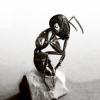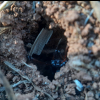No pictures?
- Formiculture.com
- Forums
- Gallery
- Members
- Member Map
- Chat

No pictures?
![]() Franz
Franz
if you find any mistakes, it's my autocorrection. it doesn't speak english.
As I prepared one of my Myrmica rubra colonies for hibernation, I wondered, what this tiny insect is, that's running around in the formicarium. To keep ants, not really sure, what species it is, often happens, but to keep one, you don't even know, that's a complete different thing.
 Ponera coarcata by franz steinleitner, auf Flickr
Ponera coarcata by franz steinleitner, auf Flickr
![]() Franz
Franz
if you find any mistakes, it's my autocorrection. it doesn't speak english.
As I prepared one of my Myrmica rubra colonies for hibernation, I wondered, what this tiny insect is, that's running around in the formicarium. To keep ants, not really sure, what species it is, often happens, but to keep one, you don't even know, that's a complete different thing.
Ponera coarcata by franz steinleitner, auf Flickr
I found queens of this species (the one in the photo) before, they are very very tiny.
Nice pictures of European ants in this thread!
There are no records of Lasius spp. from Texas at bugguide.net, but there also are not any from Kansas, South Dakota, Idaho and Nevada, where we know they abound, so this is an artifact of reporting, as well as their rarity. Lasius does occur in northernmost Texas and in the Davis and Guadalupe mountains, but they are much less common and never dominant components of the fauna, as they are in more northern regions. They also occur at least as far south as Gainesville in Florida, where I encountered both L. neoniger & L. alienus a few times, in small areas but with locally dense populations, when I lived there during the 1980s. Several species occur in the western USA and far south in Mexican mountains, and also occur in the cold (sagebrush) deserts, but are quite absent from the hot (creosote) deserts at lower altitudes and latitudes.
Anting →
Ant ID Requests →
Brookings, South Dakota, 9/12/25 Myrmica sp.Started by Ants_Dakota , Sep 13 2025 |
|

|
||
Ant Keeping →
Ant Keeping Journals →
Antz_Straya's Australian AntsStarted by Antz_Straya , Sep 7 2025 |
|

|
||
Ant Keeping →
Ant Keeping Journals →
Chickalo's Lasius neoniger (WIP Title)Started by Chickalo , Sep 1 2025 |
|

|
||
Ants & Myrmecology →
General →
Formica aserva - Founding processStarted by Stubyvast , Aug 21 2025 |
|

|
||
Anting →
General Anting →
First Lasius atopus queen ever collected?Started by bmb1bee , Aug 11 2025 |
|

|
0 members, 0 guests, 0 anonymous users